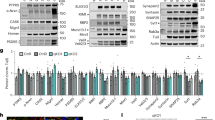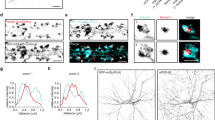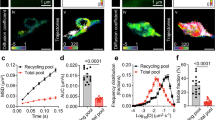Abstract
Although many of the molecules involved in synaptogenesis have been identified, the sequence and kinetics of synapse assembly in the central nervous system (CNS) remain largely unknown. We used simultaneous time-lapse imaging of fluorescent glutamate receptor subunits and presynaptic proteins in rat cortical neurons in vitro to determine the dynamics and time course of N-methyl-D-aspartate receptor (NMDAR) recruitment to nascent synapses. We found that both NMDA and α-amino-3-hydroxy-5-methyl-4-isoxazolepropionic acid receptor (AMPAR) subunits are present in mobile transport packets in neurons before and during synaptogenesis. NMDAR transport packets are more mobile than AMPAR subunits, moving along microtubules at about 4 μm/min, and are recruited to sites of axodendritic contact within minutes. Whereas NMDAR recruitment to new synapses can be either concurrent with or independent of the protein PSD-95, AMPARs are recruited with a slower time course. Thus, glutamatergic synapses can form rapidly by the sequential delivery of modular transport packets containing glutamate receptors.
This is a preview of subscription content, access via your institution
Access options
Subscribe to this journal
Receive 12 print issues and online access
$209.00 per year
only $17.42 per issue
Buy this article
- Purchase on Springer Link
- Instant access to full article PDF
Prices may be subject to local taxes which are calculated during checkout








Similar content being viewed by others
References
O'Brien, R.J. et al. The development of excitatory synapses in cultured spinal neurons. J. Neurosci. 17, 7339–7350 (1997).
Rao, A., Kim, E., Sheng, M. & Craig, A.M. Heterogeneity in the molecular composition of excitatory postsynaptic sites during development of hippocampal neurons in culture. J. Neurosci. 18, 1217–1229 (1998).
Kraszewski, K. et al. Synaptic vesicle dynamics in living cultured hippocampal neurons visualized with CY3-conjugated antibodies directed against the lumenal domain of synaptotagmin. J. Neurosci. 15, 4328–4342 (1995).
Dai, Z. & Peng, H.B. Dynamics of synaptic vesicles in cultured spinal cord neurons in relationship to synaptogenesis. Mol. Cell Neurosci. 7, 443–452 (1996).
Ahmari, S.E., Buchanan, J. & Smith, S.J. Assembly of presynaptic active zones from cytoplasmic transport packets. Nat. Neurosci. 3, 445–451 (2000).
Zhai, R.G. et al. Assembling the presynaptic active zone: a characterization of an active one precursor vesicle. Neuron 29, 131–143 (2001).
Ziv, N.E. & Garner, C.C. Principles of glutamatergic synapse formation: seeing the forest for the trees. Curr. Opin. Neurobiol. 11, 536–543 (2001).
Okabe, S., Kim, H.D., Miwa, A., Kuriu, T. & Okado, H. Continual remodeling of postsynaptic density and its regulation by synaptic activity. Nat. Neurosci. 2, 804–811 (1999).
Friedman, H.V., Bresler, T., Garner, C.C. & Ziv, N.E. Assembly of new individual excitatory synapses: time course and temporal order of synaptic molecule recruitment. Neuron 27, 57–69 (2000).
Okabe, S., Miwa, A. & Okado, H. Spine formation and correlated assembly of presynaptic and postsynaptic molecules. J. Neurosci. 21, 6105–6114 (2001).
Bresler, T. et al. The dynamics of SAP90/PSD-95 recruitment to new synaptic junctions. Mol. Cell. Neurosci. 18, 149–167 (2001).
Marrs, G.S., Green, S.H. & Dailey, M.E. Rapid formation and remodeling of postsynaptic densities in developing dendrites. Nat. Neurosci. 4, 1006–1013 (2001).
Prange, O. & Murphy, T.H. Modular transport of postsynaptic density-95 clusters and association with stable spine precursors during early development of cortical neurons. J. Neurosci. 21, 9325–9333 (2001).
Durand, G.M., Kovalchuk, Y. & Konnerth, A. Long-term potentiation and functional synapse induction in developing hippocampus. Nature 381, 71–75 (1996).
Wu, G., Malinow, R. & Cline, H.T. Maturation of a central glutamatergic synapse. Science 274, 972–976 (1996).
Isaac, J.T., Crair, M.C., Nicoll, R.A. & Malenka, R.C. Silent synapses during development of thalamocortical inputs. Neuron 18, 269–280 (1997).
Rumpel, S., Hatt, H. & Gottmann, K. Silent synapses in the developing rat visual cortex: evidence for postsynaptic expression of synaptic plasticity. J. Neurosci. 18, 8863–8874 (1998).
Liao, D., Zhang, X., O'Brien, R., Ehlers, M.D. & Huganir, R.L. Regulation of morphological postsynaptic silent synapses in developing hippocampal neurons. Nat. Neurosci. 2, 37–43 (1999).
Petralia, R.S. et al. Selective acquisition of AMPA receptors over postnatal development suggests a molecular basis for silent synapses. Nat. Neurosci. 2, 31–36 (1999).
Cottrell, J.R., Dube, G.R., Egles, C. & Liu, G. Distribution, density, and clustering of functional glutamate receptors before and after synaptogenesis in hippocampal neurons. J. Neurophysiol. 84, 1573–1587 (2000).
Scannevin, R.H. & Huganir, R.L. Postsynaptic organization and regulation of excitatory synapses. Nat. Reviews Neurosci. 1, 133–141 (2000).
Sheng, M. & Lee, S.H. AMPA receptor trafficking and the control of synaptic transmission. Cell 105, 825–828 (2001).
McAllister, A.K. & Stevens, C.F. Nonsaturation of AMPA and NMDA receptors at hippocampal synapses. Proc. Natl. Acad. Sci. USA 97, 6173–6178 (2000).
Craig, A.M., Blackstone, C.D., Huganir, R.L. & Banker, G. The distribution of glutamate receptors in cultured rat hippocampal neurons: postsynaptic clustering of AMPA-selective subunits. Neuron 10, 1055–1068 (1993).
Mammen, A.L., Huganir, R.L. & O'Brien, R.J. Redistribution and stabilization of cell surface glutamate receptors during synapse formation. J. Neurosci. 17, 7351–7358 (1997).
Niethammer, M., Kim, E. & Sheng, M. Interaction between the C terminus of NMDA receptor subunits and multiple members of the PSD-95 family of membrane-associated guanylate kinases. J. Neurosci. 16, 2157–2163 (1996).
Arnold, D.B. & Clapham, D.E. Molecular determinants for subcellular localization of PSD-95 with an interacting K+ channel. Neuron 23, 149–157 (1999).
Goldstein, L.S. & Yang, Z. Microtubule-based transport systems in neurons: the roles of kinesins and dyneins. Annu. Rev. Neurosci. 23, 39–71 (2000).
Allison, D.W., Chervin, A.S., Gelfand, V.I. & Craig, A.M. Postsynaptic scaffolds of excitatory and inhibitory synapses in hippocampal neurons: maintenance of core components independent of actin filaments and microtubules. J. Neurosci. 20, 4545–4554 (2000).
Cooper, M.W. & Smith, S.J. A real-time analysis of growth cone-target cell interactions during the formation of stable contacts between hippocampal neurons in culture. J. Neurobiol. 23, 814–828 (1992).
Dailey, M.E. & Smith, S.J. The dynamics of dendritic structure in developing hippocampal slices. J. Neurosci. 16, 2983–2994 (1996).
Ziv, N.E. & Smith, S.J. Evidence for a role of dendritic filopodia in synaptogenesis and spine formation. Neuron 17, 91–102 (1996).
Ryan, T.A. et al. The kinetics of synaptic vesicle recycling measured at single presynaptic boutons. Neuron 11, 713–724 (1993).
Shi, S.H. et al. Rapid spine delivery and redistribution of AMPA receptors after synaptic NMDA receptor activation. Science 284, 1811–1816 (1999).
Ehlers, M.D. Reinsertion or degradation of AMPA receptors determined by activity-dependent endocytic sorting. Neuron 28, 511–525 (2000).
Setou, M., Nakagawa, T., Seog, D.H. & Hirokawa, N. Kinesin superfamily motor protein KIF17 and mLin-10 in NMDA receptor-containing vesicle transport. Science 288, 1796–1802 (2000).
Migaud, M. et al. Enhanced long-term potentiation and impaired learning in mice with mutant postsynaptic density-95 protein. Nature 396, 433–439 (1998).
Chen, L. et al. Stargazin regulates synaptic targeting of AMPA receptors by two distinct mechanisms. Nature 408, 936–943 (2000).
Craig, A.M., Blackstone, C.D., Huganir, R.L. & Banker, G. Selective clustering of glutamate and γ-aminobutyric acid receptors opposite terminals releasing the corresponding neurotransmitters. Proc. Natl. Acad. Sci. USA 91, 12373–12377 (1994).
Verderio, C., Coco, S., Fumagalli, G. & Matteoli, M. Spatial changes in calcium signaling during the establishment of neuronal polarity and synaptogenesis. J. Cell. Biol. 126, 1527–1536 (1994).
Benson, D.L. & Cohen, P.A. Activity-independent segregation of excitatory and inhibitory synaptic terminals in cultured hippocampal neurons. J. Neurosci. 16, 6424–6432 (1996).
Verhage, M. et al. Synaptic assembly of the brain in the absence of neurotransmitter secretion. Science 287, 864–869 (2000).
Schoch, S. et al. SNARE function analyzed in synaptobrevin/VAMP knockout mice. Science 294, 1117–1122 (2001).
Washbourne, P. et al. Genetic ablation of the t-SNARE SNAP-25 distinguishes mechanisms of neuroexocytosis. Nat. Neurosci. 5, 19–26 (2002).
Benson, D.L. & Tanaka, H. N-cadherin redistribution during synaptogenesis in hippocampal neurons. J. Neurosci. 18, 6892–6904 (1998).
Dalva, M.B. et al. EphB receptors interact with NMDA receptors and regulate excitatory synapse formation. Cell 103, 945–956 (2000).
Scheiffele, P., Fan, J., Choih, J., Fetter, R. & Serafini, T. Neuroligin expressed in nonneuronal cells triggers presynaptic development in contacting axons. Cell 101, 657–669 (2000).
Marshall, J., Molloy, R., Moss, G.W., Howe, J.R. & Hughes, T.E. The jellyfish green fluorescent protein: a new tool for studying ion channel expression and function. Neuron 14, 211–215 (1995).
Bekkers, J.M. & Stevens, C.F. NMDA and non-NMDA receptors are co-localized at individual excitatory synapses in cultured rat hippocampus. Nature 341, 230–233 (1989).
Aarts, L.H. et al. B-50/GAP-43-induced formation of filopodia depends on Rho-GTPase. Mol. Biol. Cell 9, 1279–1292 (1998).
Acknowledgements
We thank J. Sullivan for help in constructing the NR1 and GluR1 fusion constructs; S. Heinemann for providing NR1 and GluR1 cDNAs; M. Sheng for providing PSD-95-EGFP27; R. Scheller for VAMP2-EGFP5; N. Perrone-Bizzozero for GAP43-EGFP50; S. Vicini, J. Luo and Z. Fu for the EGFP-NR1 (N-terminal fusion construct); R. Huganir for his gift of guinea pig anti-GluR1 antibody and the Jones lab at UC Davis for sharing resources. Thanks also to the Ehlers lab at Duke University for the lipofection protocol and to K. Murray, S. Sabo and W.M. Usrey for reading the manuscript. This work was supported by the Alfred P. Sloan Foundation, the Pew Charitable Trusts, the March of Dimes and NIH RO1 EY13584 (A.K.M.). P.W. is a M.I.N.D. Institute Scholar.
Author information
Authors and Affiliations
Corresponding author
Ethics declarations
Competing interests
The authors declare no competing financial interests.
Supplementary information
Supplementary Fig. 1.
Movement of an NMDAR transport packet. A 3 d.i.v. cerebral cortical neuron transfected with NR1-DsRed and imaged at 35°C, 24 h after transfection. This time-lapse movie demonstrates movement of an NMDAR transport packet (arrow) in a retrograde direction along a proximal dendrite. NR1-DsRed is in red. Images were acquired every 2 min. A total of 17 frames, corresponding to 32 min of imaging, is compressed to 2 s. (AVI 1553 kb)
Supplementary Fig. 2.
Recruitment of NR1-DsRed to a site of contact with an axon growth cone filopodium. Cortical neurons 3 d.i.v. 'trans' cotransfected with NR1-DsRed (red) and GAP43-EGFP (green) were imaged at 34°C, 16 h after transfection. Growth cone filopodia contacted the NR1-positive dendrite repeatedly, causing recruitment of an NMDAR transport packet to the site of contact. Both the contact and the NMDAR transport packet were then stabilized. Images were acquired every 90 s. A total of 15 frames, corresponding to 21 min of imaging, is compressed to 2 s. (AVI 1321 kb)
Rights and permissions
About this article
Cite this article
Washbourne, P., Bennett, J. & McAllister, A. Rapid recruitment of NMDA receptor transport packets to nascent synapses. Nat Neurosci 5, 751–759 (2002). https://doi.org/10.1038/nn883
Received:
Accepted:
Published:
Issue Date:
DOI: https://doi.org/10.1038/nn883
This article is cited by
-
Non-canonical interplay between glutamatergic NMDA and dopamine receptors shapes synaptogenesis
Nature Communications (2024)
-
Estimation of the number of synapses in the hippocampus and brain-wide by volume electron microscopy and genetic labeling
Scientific Reports (2020)
-
Structural features in the glycine-binding sites of the GluN1 and GluN3A subunits regulate the surface delivery of NMDA receptors
Scientific Reports (2019)
-
Dynamic assembly of ribbon synapses and circuit maintenance in a vertebrate sensory system
Nature Communications (2019)
-
Versatile control of synaptic circuits by astrocytes: where, when and how?
Nature Reviews Neuroscience (2018)



